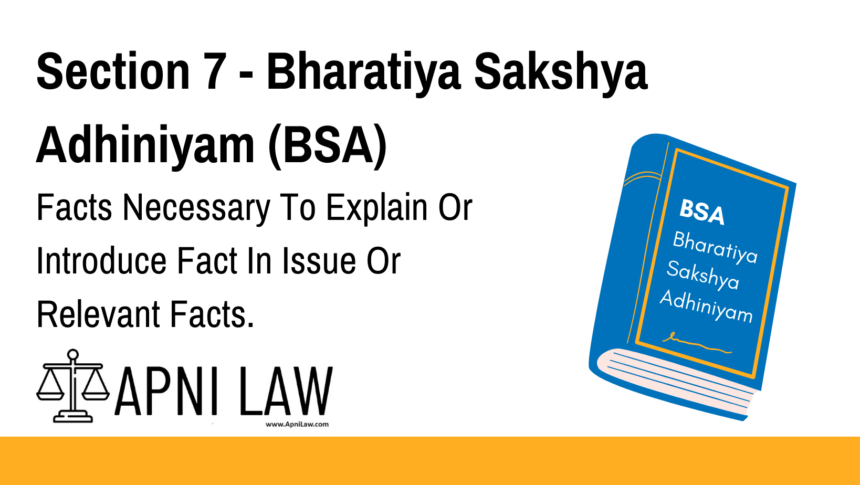Code
Facts necessary to explain or introduce a fact in issue or relevant fact, or which
support or rebut an inference suggested by a fact in issue or a relevant fact, or which
establish the identity of anything, or person whose identity, is relevant, or fix the time or
place at which any fact in issue or relevant fact happened, or which show the relation of
parties by whom any such fact was transacted, are relevant in so far as they are necessary
for that purpose.
Illustrations.
(a) The question is, whether a given document is the will of A. The state of A’s
property and of his family at the date of the alleged will may be relevant facts.
(b) A sues B for a libel imputing disgraceful conduct to A; B affirms that the matter
alleged to be libellous is true. The position and relations of the parties at the time when the
libel was published may be relevant facts as introductory to the facts in issue. The particulars
of a dispute between A and B about a matter unconnected with the alleged libel are irrelevant,
though the fact that there was a dispute may be relevant if it affected the relations between
A and B.
(c) A is accused of a crime. The fact that, soon after the commission of the crime, A
absconded from his house, is relevant under section 6, as conduct subsequent to and
affected by facts in issue. The fact that, at the time when he left home, A had sudden and
urgent business at the place to which he went, is relevant, as tending to explain the fact that
he left home suddenly. The details of the business on which he left are not relevant, except
in so far as they are necessary to show that the business was sudden and urgent.
(d) A sues B for inducing C to break a contract of service made by him with A. C, on
leaving A’s service, says to A—”I am leaving you because B has made me a better offer”.
This statement is a relevant fact as explanatory of C’s conduct, which is relevant as a fact in
issue.
(e) A, accused of theft, is seen to give the stolen property to B, who is seen to give it
to A’s wife. B says as he delivers it—”A says you are to hide this”. B’s statement is relevant
as explanatory of a fact which is part of the transaction.
(f) A is tried for a riot and is proved to have marched at the head of a mob. The cries of
the mob are relevant as explanatory of the nature of the transaction.
Explanation
Section 7 brings in supporting or connecting facts that, while not directly forming part of the fact in issue or relevant fact, help:
- Introduce or explain them,
- Confirm or deny inferences,
- Establish identity of people, items, times, or places, and
- Clarify relationships of parties involved in the transaction.
It allows the court to fill in the background and context to get a clearer, more complete picture of the event or circumstance under legal scrutiny.
Illustrations
- (a) Will Dispute: The state of A’s property and family at the time of the alleged will is relevant.
- (b) Libel Suit: The relationship between A and B at the time of publishing the libel is relevant. But a prior, unrelated dispute is not, unless it affects their relation.
- (c) Absconding: If A flees after a crime (relevant under Section 6), his sudden and urgent business at the place he went to is relevant to explain his flight — but not the detailed nature of the business.
- (d) Contract Interference: C says, “I’m leaving because B made me a better offer.” This explains C’s conduct, which is a fact in issue.
- (e) Theft: A gives stolen property to B, who gives it to A’s wife saying, “A says you are to hide this.” B’s statement explains a relevant transaction.
- (f) Riot: A leads a mob. The cries of the mob explain the nature of the riot and A’s participation.
Common Questions and Answers
🔸 Q1. Are background facts always admissible?
Only if they help introduce, explain, or support facts in issue or relevant facts. Mere unrelated history is not admissible.
🔸 Q2. Can explanations of behavior justify guilt or innocence?
They don’t directly prove guilt or innocence but can provide crucial context or rebut inferences.
🔸 Q3. Are statements of third parties (like B’s in example e) always admissible?
Only if they explain a relevant act or form part of a transaction under consideration.








